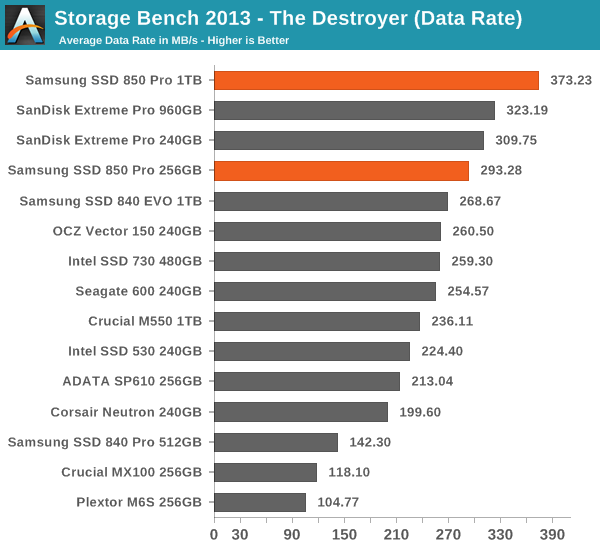Samsung SSD 850 Pro (128GB, 256GB & 1TB) Review: Enter the 3D Era
by Kristian Vättö on July 1, 2014 10:00 AM ESTAnandTech Storage Bench 2013
Our Storage Bench 2013 focuses on worst-case multitasking and IO consistency. Similar to our earlier Storage Benches, the test is still application trace based - we record all IO requests made to a test system and play them back on the drive we are testing and run statistical analysis on the drive's responses. There are 49.8 million IO operations in total with 1583.0GB of reads and 875.6GB of writes. I'm not including the full description of the test for better readability, so make sure to read our Storage Bench 2013 introduction for the full details.
| AnandTech Storage Bench 2013 - The Destroyer | ||
| Workload | Description | Applications Used |
| Photo Sync/Editing | Import images, edit, export | Adobe Photoshop CS6, Adobe Lightroom 4, Dropbox |
| Gaming | Download/install games, play games | Steam, Deus Ex, Skyrim, Starcraft 2, BioShock Infinite |
| Virtualization | Run/manage VM, use general apps inside VM | VirtualBox |
| General Productivity | Browse the web, manage local email, copy files, encrypt/decrypt files, backup system, download content, virus/malware scan | Chrome, IE10, Outlook, Windows 8, AxCrypt, uTorrent, AdAware |
| Video Playback | Copy and watch movies | Windows 8 |
| Application Development | Compile projects, check out code, download code samples | Visual Studio 2012 |
We are reporting two primary metrics with the Destroyer: average data rate in MB/s and average service time in microseconds. The former gives you an idea of the throughput of the drive during the time that it was running the test workload. This can be a very good indication of overall performance. What average data rate doesn't do a good job of is taking into account response time of very bursty (read: high queue depth) IO. By reporting average service time we heavily weigh latency for queued IOs. You'll note that this is a metric we have been reporting in our enterprise benchmarks for a while now. With the client tests maturing, the time was right for a little convergence.

Thanks to the excellent IO consistency, the 850 Pro dominates our 2013 Storage Bench. At the 1TB capacity point, the 850 Pro is over 15% faster than any drive when looking at the average data rate. That is huge because the 850 Pro has less over-provisioning than most of today's high-end drives and the 2013 Storage Bench tends to reward drives that have more over-provisioning because it essentially pushes drives to steady-state. The 256GB model does not do as well as the 1TB one but it is still one of the fastest drives in its class. I wonder if the lesser amount of over-provisioning is the reason or perhaps the Extreme Pro is just so well optimized for mixed workloads.











160 Comments
View All Comments
Cerb - Tuesday, July 1, 2014 - link
"cheese in in" -> "cheese in it"?Cerb - Tuesday, July 1, 2014 - link
The above was meant to not be a reply to yours. In general, there's isn't much, though, because with SATA, we're still stuck needing striped RAID to improve bandwidth. Assuming they can keep costs in check, the rapid shrinking,m and thus capacity increases over the next few years, will give us something much more useful. That said, it's nice that they caught up in terms of consistency.Donuts123 - Sunday, July 6, 2014 - link
More relevantly, the 150TB warranty figure applies to all capacities. All things being equal, a 128GB drive with 150TB written will have the same amount of flash wear as a 1TB drive with 1200TB written.So in practice the 1TB model will have far higher endurance than 150TB. But its warranty will expire when its flash is only 12.5% worn. Samsung aren't the only manufacturer to have low TBW warranty figures; Micron/Crucial does it as well, with the same TBW figure for all drive capacities.
8steve8 - Tuesday, July 1, 2014 - link
Yawn. Another SATA 2.5" SSD.How does this compare to m.2 PCIe drives like the XP941 and M6e?
Will we see m.2 PCIe NVMe drives before xmas?
Kristian Vättö - Tuesday, July 1, 2014 - link
The 850 Pro is now in the Bench so you can compare the two easily:http://www.anandtech.com/bench/product/1201?vs=125...
8steve8 - Tuesday, July 1, 2014 - link
thanks, the XP941 demolishes this thing, why isn't it in the charts of this review? clearly PCIe m.2 would be on the radar for anyone looking for a high end SSD these days... ?it may not be readily available in the channels, but it is a taste of what is to come... personally I just got a 256GB plextor M6e PCIe m.2 for $220. It's easy to find in the market.
Kristian Vättö - Tuesday, July 1, 2014 - link
I didn't want to put the XP941 in the graphs because the availability and support are relatively limited and it would have broken some of the graphs.zmeul - Tuesday, July 1, 2014 - link
just a quick dumb question:the bandwidth for SATA 3.0 - 6 Gbit/s is 600 MB/s right? so, it's 300MB/s read and 300MB/s write
correct ?
thesavvymage - Tuesday, July 1, 2014 - link
no, its 600MB/s in total in either direction. you can max the 600 read if you arent doing any writes, etc. It isnt 300 max per direction, its 600 max for total data bandwidthzmeul - Tuesday, July 1, 2014 - link
yes, I forgot to mention, duplex (at the same time) 300r+300w